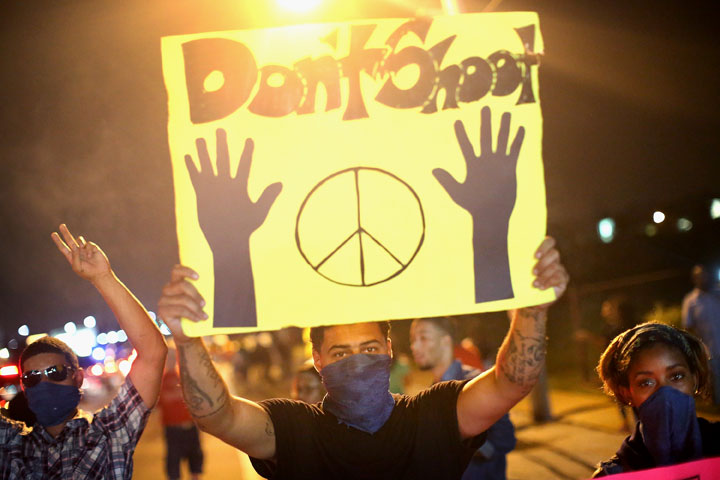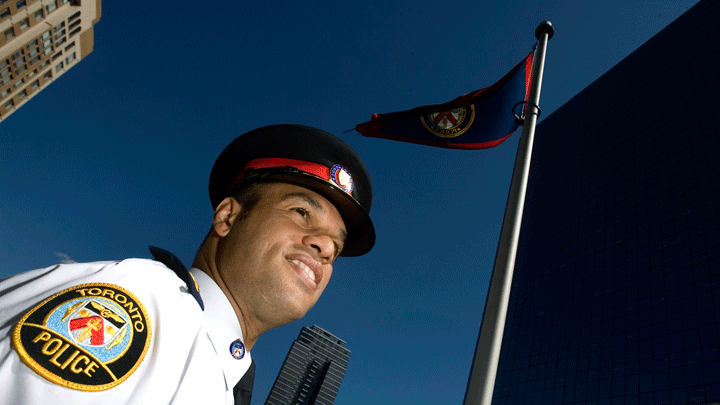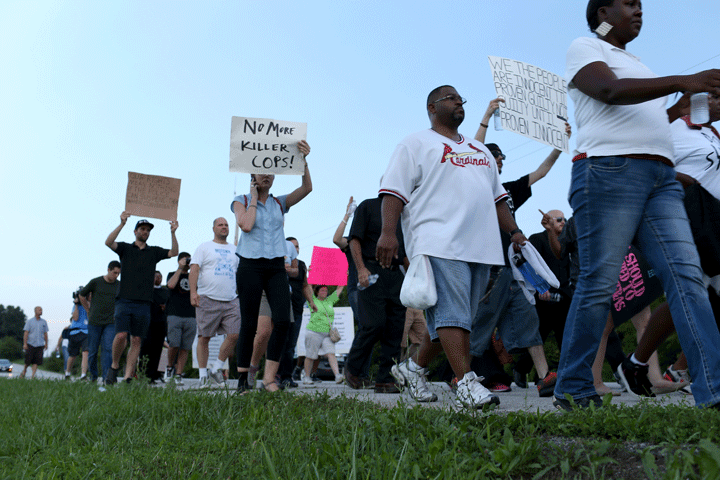TORONTO – The fatal shooting of teenager Michael Brown by a police officer in Ferguson, Missouri happened 1,000 kilometres from, and a year after, teenager Sammy Yatim was fatally shot by an officer in Toronto.

Both victims were 18 years old and both were shot multiple times but their deaths came after very different circumstances — Yatim was wielding a knife on a streetcar and Brown was unarmed and walking on the street.
While there were anti-police protests in Toronto following Yatim’s death, there was none of the rioting and looting witnessed in Ferguson, where the black majority population is policed by mostly white officers.

Toronto police chief Bill Blair has said his force will likely never have to deal with the same kind of racial tension.
“We work really closely with the minority communities here in Toronto,” said Blair at an Aug. 14 press conference. “I think those relationships that we worked for so many years on building, and that the trust that exists between us would help us through such a crisis.
“I’m also confident there’s a great deal in place in the training of our people and the work that they do that it would be less likely to happen here.”
Implicit biases: Not your racist grandpa
Toronto police training was significantly impacted by 2013’s Police and Community Engagement Review (the PACER report)—which came out three months after Yatim’s death. The report made 31 recommendations, including many related to bias, prejudices, racial profiling, and public trust—and recommended a review of training protocols and the introduction of new training.
One new program is being conducted by the “pre-eminent trainer in the United States on implicit bias,” said Deputy Chief Peter Sloly.
That trainer is Dr. Lorie Fridell, a social scientist who teaches at the University of South Florida, and founded the Fair and Impartial Policing program. The Toronto Police Service is the first law enforcement agency she’s worked with in Canada, but she plans to train the Vancouver Transit Authority in January.

Fridell said bias has changed in our society: When it manifested “in our grandparents’ time” it was most likely to look like what we now call explicit bias—people who consciously linked others to stereotypes. “A racist would be an example,” she said.
But implicit bias is different—and that’s what the Fair and Impartial Policing program aims to tackle.
Social science research suggests these biases come from entertainment media, news media, as well as individual upbringing and environment, said Fridell.
“That’s where we go wrong: Treating all people of colour as if they’re criminals, treating all women as if they’re not.”
It’s a lesson Sloly says is particularly important for police.
“When you’re a human being in general society, you’re not necessarily held to that account – when you’re a police officer, and you’re sworn to uphold the law and be compliant with the Charter and the Human Rights Code, you can’t allow that thinking to impact your decisions.”
How to combat biases when you don’t know you’re biased
Fridell gives police two tactics to combat these biases: one is recognizing your own biases and actively choosing to implement unbiased behaviour.
“For me, as a professor, I might have a blink response depending on who darkens my doorway,” said Fridell. “Maybe it’s an Asian female versus a Hispanic in a football jersey. And as you might imagine, I have very different academic stereotypes associated with those groups—and I’m sorry I have them, but I do—but the key here is that I recognize them and make sure that my behaviour is bias-free.”
Sloly said another new training tool that comes on the heels of the Fair and Impartial Policing program is intercultural competence development training, brought in by another American company— Intercultural Developmental Inventory (IDI). Though the IDI assessment has been used in educational institutions, non-profit organizations and companies in the country, the Toronto Police Service is the first law enforcement agency to use it for organization-wide assessment and training in Canada, according to IDI owner and president Mitch Hammer.
The deputy chief described it as a survey diagnostic that allows officers to recognize how their own cultural/racial/religious background will come into play with the background of other people with whom they interact.
“The part of me that is a Jamaican-born, black person can be a more dominant factor in certain circumstances. The part of me that’s a 25-year police officer at the rank of a deputy chief, can in other cases become a more dominant factor. And the part of me that’s the dad of a young family in a mixed marriage can also be a different factor – and…most times all three are at play. So how do you recognize that, how do you decode that, and how do you manage that better, more consistently—both at home and at work?”
Contact theory and getting into high-crime neighbourhoods
The second tactic Fridell uses to combat implicit biases has to do with contact theory, which says if we interact in a positive way with people different from us, that interaction will reduce both our conscious and implicit biases. Fridell’s personal example was volunteering at a homeless shelter—watching movies, having conversations—to reduce her own bias that homeless people were a threat.
She acknowledged that police work inevitably involves a number of negative interactions, but suggested there’s an increasing emphasis in policing to make positive contacts with the “good people” in various neighbourhoods.
It’s a shift Toronto Police seems to have embraced.
“We have consultative committees with demographic groups: Aboriginal First Nations, the black community, the Asian community, the South Asian community, the LGBTQ community as examples, and those are all high -level, chief command-level consultative communities that meet on a monthly basis and have done so over the last two decades,” Sloly said.
He added there are additional consultative committees at the divisional level—“if it’s an area with a high Chinese population, there might be a Chinese consultative committee like there is in 42 division”—and at the neighbourhood level where there are high levels of victimization and crime.
“Because we are the most diverse city in the world, and because crime and disorder doesn’t happen equally in a city like ours, we have to be highly focused on relationship-building with victimized communities, with marginalized communities; in the world’s most diverse city, with racialized communities, or new immigrant communities,” said Sloly.
“If you don’t have a trusting relationship with broad members of your community, then you can’t really get to a level of safety that’s acceptable.”
Why it comes down to trust
The issue of trust is at the centre of Fridell’s analysis of the death of Brown: “what we’re seeing in Ferguson is a great deal of mistrust between the African-American community and the police.”
“In every community there’s a great deal of concern about this, and they want answers and they want investigations–but in some other communities they have enough trust to say, ‘Okay, I think this is going to get investigated and, as necessary, people are going to be held to account.’”
Sloly called the relationship between police and minority communities “the number one public trust issue that we struggle with.”
“That’s what the whole Police and Community Engagement Review is about – acknowledging it, recognizing it, and putting in place systemic level programs and individual supports to help our people be the best they can be…
“I’m not sure that we can eliminate racism or bias out of a public institution any more than we can eliminate it out of society, but we’re going to do our best to get as close to that goal as we possibly can.”






Comments